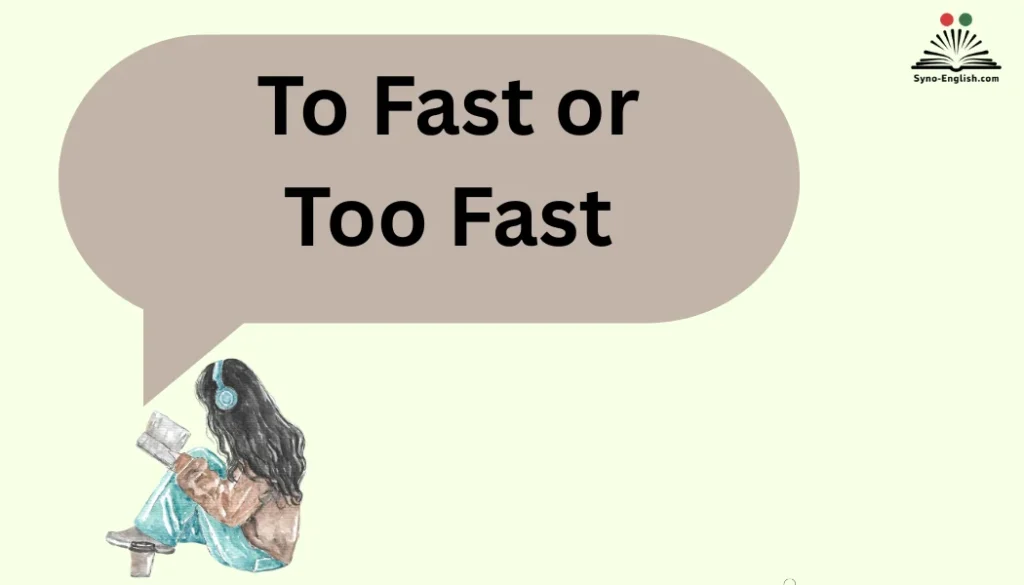The English language can be tricky, especially when an extra letter changes the entire meaning of a sentence. Understanding To Fast or Too Fast takes patience and awareness—each version sounds identical, yet they mean something very different.
One refers to abstaining from eating, and the other describes moving at high speed. I still remember my confusion as a student when I made this mistake in writing, but gaining understanding of this difference improved my communication skills and gave me more confidence to write clearly.Through dedicated study, I realized that grammar rules are more than just marks of correctness—they build clarity.
Many common mistakes happen because of not noticing how one letter or word placement changes the message. I’ve often used examples, tables, and case studies in my lessons to show how small changes can confuse readers. Even one missing or extra detail can alter a sentence’s entire meaning.
Why “To Fast” vs. “Too Fast” Trips People Up
Picture this: you’re texting a friend after a thrilling car ride and write, “He was driving to fast.” Your friend may pause, confused. Did you mean the driver was fasting for health reasons, or simply going too fast?
That single missing “o” changes the meaning completely.
- “To fast” can exist but only if you’re talking about fasting, as in abstaining from food: “She decided to fast for 24 hours.”
- “Too fast” means something is moving at excessive speed: “He drives too fast on the highway.”
This confusion happens because the words “to” and “too” are homophones. They sound the same but serve different grammatical purposes.
Understanding the Grammar: ‘To’ vs. ‘Too’
Before diving into specific phrases like “too fast,” let’s build a foundation.
To is usually a preposition or part of an infinitive verb. It shows direction, purpose, or relation.
Examples:
- I’m going to the store.
- He loves to run.
Too is always an adverb. It can mean “also,” “in addition,” or “excessively.”
Examples:
- She’s coming with us too.
- The soup is too salty.
Here’s a quick comparison:
| Word | Part of Speech | Core Meaning | Examples |
| To | Preposition/infinitive marker | Direction, purpose, relationship | Go to school, want to eat |
| Too | Adverb | Excess, agreement, emphasis | Too fast, me too, too tired |
Key takeaway: If you’re showing direction or purpose, use to. If you’re showing excess or agreement, use too.
Common Misuses of ‘To’ and ‘Too’
Many mistakes stem from typing quickly or not proofreading. Let’s look at the biggest culprits.
- Wrong: He was driving to fast.
- Right: He was driving too fast.
- Wrong: I want too eat pizza.
- Right: I want to eat pizza.
- Wron: She’s coming with us to.
- Right: She’s coming with us too.
Mistakes like these pop up constantly on social media, texting apps, and even professional emails. The similarity in sound tricks the brain, but readers catch on instantly.
When ‘Too’ Goes Before Adjectives and Adverbs
The rule here is simple: “Too” always comes directly before the adjective or adverb it modifies.
Examples:
- The coffee is too hot.
- He ran too quickly.
- They arrived too late.
Think of “too” as a spotlight. It shines directly on the word it modifies.
Diagram (described textually):
- Sentence: The car is too fast.
- Subject → “car”
- Verb → “is”
- Modifier → “too fast” (adverb + adjective combo)
Examples of ‘Too’ in Excessive Situations
“Too” often signals that something exceeds a normal or acceptable limit.
- Too loud: The music was too loud for the neighbors.
- Too expensive: That watch is too expensive for my budget.
- Too much: She put too much sugar in the tea.
Case Study:
In 2018, the UK government ran a road safety campaign. Their slogan was:
“Don’t drive too fast. Someone’s life depends on it.”
This shows how “too fast” isn’t just grammar—it has real-world consequences.
The Adverb ‘Too’: Enhancing Your Vocabulary
Using “too” strategically can strengthen your writing. It brings precision and emotion.
- For emphasis: I’m too tired to move.
- For agreement: I love that song. → Me too.
- For exaggeration in storytelling: It was too funny to forget.
Expressing Emphasis with ‘Too’
Writers often use “too” for emphasis. It signals something is beyond ordinary.
- It’s too good to be true.
- The movie was too long.
Notice how “too” carries emotional weight here. It’s not neutral—it pushes the reader to feel the excess.
Showing Addition and Agreement
Besides excess, “too” also means “also” or “in addition.”
Examples:
- I want ice cream too.
- Can I come too?
This use often comes at the end of a sentence, making it easy to spot.
Synonyms for ‘Too’
Sometimes, repeating “too” can feel redundant. Here are synonyms depending on meaning.
| Meaning | Synonyms | Example |
| Excessive | overly, extremely, excessively, incredibly | The task was overly difficult. |
| Agreement | as well, also, likewise, in addition | I love books, and movies as well. |
Using alternatives keeps writing fresh and avoids monotony.
Grammar Tips: Remembering the Difference
Here are quick hacks:
- Visual trick: Too has an extra “o,” meaning extra or more.
- Mnemonic: Too = extra; To = direction.
- Proofreading tip: Read aloud. If it doesn’t sound right, it probably isn’t.
Visual Tricks to Differentiate ‘To’ and ‘Too’
Try this:
- Draw two circles side by side (OO in “too”). Tell yourself: Extra O = Extra amount.
- Draw a straight arrow → and label it “to.” That arrow shows direction.
Simple visuals stick in memory far better than dry definitions.
Mnemonics for Correct Usage
Here are some memory aids you can keep in mind:
- Too = Overdo. If you’re overdoing it, use “too.”
- To = Toward. If you’re heading toward something, use “to.”
‘Too Fast’ or ‘Too Quick’? Exploring Adverbs of Manner
Here’s where nuance matters. “Fast” and “quick” overlap but aren’t identical.
| Word | Usage | Example |
| Fast | Focus on speed/time | He runs too fast for me to keep up. |
| Quick | Focus on action/responses | She gave too quick of an answer. |
Fast often applies to movement or measurable speed.
- Quick often applies to reactions, actions, or decisions.
Example:
- A car moves too fast.
- A reply comes too quick.
When ‘To’ and ‘Too’ Sound Alike: Homophones Clarified
Homophones—words that sound alike but mean different things—are grammar landmines. “To” and “too” top the list.
| Word | Pronunciation | Role | Example |
| To | /tuː/ | Preposition/infinitive | I’m going to work. |
| Too | /tuː/ | Adverb | It’s too cold outside. |
For ESL learners, these words can be especially frustrating. The key is not sound but function. Train yourself to recognize context clues.
Practice Section: Test Yourself
Try these exercises. Answers follow below.
Fill in the blanks with to or too:
- He walked ___ the park.
- She was driving ___ fast for the road.
- I want ___ learn Spanish.
- That box is ___ heavy for me.
- Can I come ___?
Answers:
- to
- too
- to
- too
- too
Conclusion
Mastering the distinction between To Fast or Too Fast is not only about grammar but also about developing precision in communication. The English language may be tricky, yet understanding the difference between these phrases helps improve both clarity and confidence. Knowing when to use “to fast” for abstaining from eating and “too fast” for describing excessive speed demonstrates attention to meaning, context, and detail. Such awareness keeps your writing accurate and your message easily understood by readers.
Consistent practice, exercises, and examples are vital tools in developing grammatical skills. The more you apply rules, use tricks, and review case studies, the more your understanding and awareness will sharpen. Even a single extra letter can change meaning entirely, so staying mindful of these subtle differences ensures smoother communication. By practicing daily and observing common mistakes, you’ll not only avoid confusion but also gain mastery over the English language, turning each sentence into a clear and confident expression of thought.
FAQs
What does “to fast” mean?
It means to abstain from eating food, often for religious or health purposes, and has nothing to do with speed.
What does “too fast” mean?
It means something is moving at a high or excessive speed, referring to pace or quickness.
Why do people confuse “to fast” and “too fast”?
They sound identical, so many learners mix them up in writing or communication.
How can I remember the difference?
Think of “too” as meaning “excessive.” When in doubt, replace it with “very” to check if it fits.
Is “to fast” grammatically correct?
Yes, but only when used to mean abstaining from food, not when describing speed.
Can “too fast” ever be used in a positive sense?
Yes, sometimes it shows enthusiasm, like “The project finished too fast,” meaning it ended quickly.
How can I improve at spotting such mistakes?
Practice with daily exercises, read examples, and study similar confusing phrases.
Are there other phrases like “to fast” vs “too fast”?
Yes, phrases like “to” vs “too,” “your” vs “you’re,” and “their” vs “there” cause similar confusion.
Why is grammar so important in communication?
Good grammar keeps your message clear and prevents misunderstanding in personal and professional writing.
What’s the best way to master this difference?
Use guides, case studies, and consistent practice to sharpen your skills and build confidence.

Emma Brooke is a passionate English educator, writer, and language enthusiast with over a decade of experience helping learners master the nuances of the English language. At SynoEnglish, she blends practical grammar advice with real-world communication tips to make English easier, clearer, and more enjoyable for readers of all levels.



